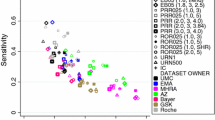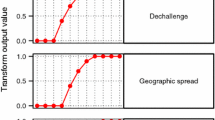Abstract
This paper describes a new method of prioritising signals of potential adverse drug reactions (ADRs) detected from spontaneous reports that is called impact analysis. This is an interim step between signal detection and detailed signal evaluation. Using mathematical screening tools, large numbers of signals may now be detected from spontaneous ADR databases. Regulatory authorities need to rapidly prioritise them and focus on those that are most likely to require significant action. Using two scores ranging from one to 100, each with three input variables, signals may be categorised in terms of the strength of evidence (E) and the potential public health impact (P). In a two-by-two figure with empirically derived cut-off points of ten (the logarithmic mean) for each score, signals are placed in one of four categories (A–D) that are ranked according to their priority (A being the highest and D the lowest). A sensitivity analysis is then performed that tests the robustness of the categorisation in relation to each of the six input variables. A computer program has been written to facilitate the process and reduce error. Further work is required to test the feasibility and value of impact analysis in practice.




Similar content being viewed by others

References
Waller PC, Wood SM. Regulatory aspects of adverse drug reactions. In: Davies DM, Ferner RE, de Glanville H, editors. Davies's textbook of adverse drug reactions. 5th ed. London: Chapman & Hall Medical, 1998: 20–28
World Health Organisation definition of a signal [online]. Available from URL: u]http://www.who-umc.org/defs.html [Accessed 2004 Aug 31]
Meyboom RHB, Egberts ACG, Edwards IR, et al. Principles of signal detection in pharmacovigilance. Drug Saf 1997; 16: 355–65
Gould AL. Practical pharmacovigilance analysis strategies. Pharmacoepidemiol Drug Saf 2003; 12: 559–74
Evans SJW, Waller PC, Davis S. Use of proportional reporting ratios (PRRs) for signal generation from spontaneous adverse drug reaction reports. Pharmacoepidemiol Drug Saf 2001; 10: 483–6
Meyboom RH, Lindquist M, Egberts AC, et al. Signal selection and follow-up in pharmacovigilance. Drug Saf 2002; 25: 459–65
Bright RA, Nelson RC. Automated support for pharmacovigilance: a proposed system. Pharmacoepidemiol Drug Saf 2002; 11: 121–5
van Puijenbroek EP, van Grootheest K, Diemont WL, et al. Determinants of signal selection in a spontaneous reporting system for adverse drug reactions. Br J Clin Pharmacol 2001; 52: 579–86
Waller PC, Lee EH. Responding to drug safety issues. Pharmacoepidemiol Drug Saf 1999; 8: 535–52
Stahl M, Lindquist M, Edwards IR, et al. Introducing triage logic as a new strategy for the detection of signals in the WHO drug monitoring database. Pharmacoepidemiol Drug Saf 2004; 13: 355–63
Waller PC, Evans SJW. A model for the future conduct of pharmacovigilance. Pharmacoepidemiol Drug Saf 2003; 12: 17–29
Acknowledgements
We thank Stephen Evans and Rosalind Coulson for valuable discussions and Peter Waller for his help in developing a computer program to facilitate the method described.
Funding was provided internally by the MHRA. The authors have no conflicts of interest that are directly relevant to the content of this study.
Author information
Authors and Affiliations
Corresponding author
Rights and permissions
About this article
Cite this article
Waller, P., Heeley, E. & Moseley, J. Impact Analysis of Signals Detected from Spontaneous Adverse Drug Reaction Reporting Data. Drug-Safety 28, 843–850 (2005). https://doi.org/10.2165/00002018-200528100-00002
Published:
Issue Date:
DOI: https://doi.org/10.2165/00002018-200528100-00002



